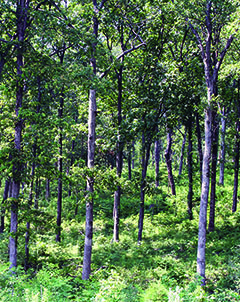
As a forest landowner, you may someday contemplate the sale of your timber (Figure 1). The gain from the sale of the timber can represent either a capital gain or an ordinary income gain. In either case, you will be required to pay taxes on the gain. Gain is the operative word, implying that you may subtract something from the total amount you received. In fact, you may subtract the total amount you spent to acquire the asset. To minimize the amount of gain and thereby reduce your tax liability, you need to establish the cost basis in your capital assets such as timber.
Establishing timber cost basis
Establishment of cost basis requires that you calculate the proportionate amount of the original purchase price that you spent on the timber. It is best to do these calculations soon after acquiring timbered property, but it may also be accomplished years later if you have maintained good records.
To establish your timber cost basis, you must have an inventory of the merchantable timber volume at the time you acquired the property. If a timber inventory has not been done, a forester can “cruise” the timber and estimate both the current volume and what it was when you acquired the property. An estimate of fair market value is also provided as part of the inventory.
Once you have an inventory of your timber, you need to calculate the proportion (the percentage in decimal form) of each asset to the total fair market value or appraised value. Here’s an example. Suppose you acquire a 100-acre woodland property for $230,000, and as part of the purchase, you incur additional costs of $2,000 to hire a forester to complete an inventory, $2,500 for a boundary survey, and $1,500 for closing costs. The total acquisition cost is then $236,000 ($230,000 + $2,000 + $2,500 + $1,500). The forester’s inventory lists 40 mbf (thousand board feet) of walnut sawlogs valued at $48,000, 19 mbf of walnut veneer logs valued at $47,500, and 100 mbf of mixed oak/hickory sawlogs valued at $22,500. The total appraised value of the property is $225,000, which could also include buildings; fence; merchantable timber, as identified above; bare land; and a young, non merchantable tree plantation.
To calculate the proportionate value of each timber product, divide the appraised value of the product by the total appraised valued of the property.
- Walnut sawlogs: $48,000 ÷ $225,000 = 0.2133
- Walnut veneer logs: $47,500 ÷ $225,000 = 0.2111
- Oak/hickory sawlogs: $22,500 ÷ $225,000 = 0.1
To calculate the original cost basis of each product, multiply its proportionate value, the decimal, by the total acquisition price.
- Walnut sawlogs: $236,000 x 0.2133 = $50,338.80
- Walnut veneer logs: $236,000 x 0.2111 = $49,819.60
- Oak/hickory sawlogs: $236,000 x 0.1 = $23,600
By doing these calculations, you can recover your cost basis in the timber account when the timber is harvested or when the logs are cut from the timber and sold or used in your business. This process of recovery is called depletion.
Calculating taxable gain from a timber sale
Using the above example, assume you completed a sale of 10,000 board feet of walnut veneer trees for a price of $35,000 soon after acquiring the property. To determine the taxable gain on the sale, you would first need to calculate the depletion unit rate and the depletion deduction allowance. To calculate the depletion unit rate, divide the original basis — or the adjusted basis, if the timber has grown or changed in some other way over time — by the current volume in the account: $49,819.60 ÷ 19,000 board feet = a depletion unit rate of $2.62 per board foot. If you were to sell 10,000 board feet immediately after purchase, then your depletion deduction allowance would be $2.62 per board foot x 10,000 board feet = $26,200. You may also deduct all costs associated with administration of the sale. In this example, you hire a consulting forester to select and mark the trees to be sold, advertise the sale, advise you in selecting the best bid, and monitor the harvesting operations. The forester charged you 10 percent of the sale price, or $3,500. So, federal income tax would be paid on the net gain shown below.
If you were in the 28 percent federal income tax bracket, your action of establishing the cost basis of your timber would have saved you more than $8,300 in tax liability because you would pay tax on $5,300 instead of $35,000.
Contact a consulting forester or public agency forester if you have an interest in completing an inventory of your timber. An inventory is the first step in realizing significant tax savings on timber income.
Additional information
- Greene, John L., William C. Siegel, William L. Hoover, and Mark Koontz. 2013. Forest landowners’ guide to the federal income tax (PDF). Agriculture Handbook 731. Washington, D.C.: U.S. Department of Agriculture.
- National Timber Tax Website
Original authors
John Dwyer and Shelby Jones